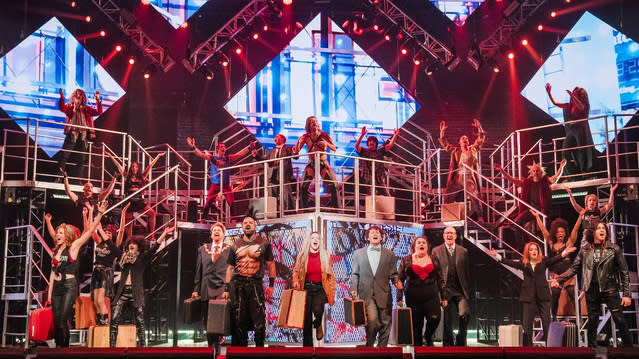Lectrosonics Is a Jukebox Hero for 'Rock of Ages'
- Oops!Something went wrong.Please try again later.

Originating on Broadway, Rock of Ages opened to a packed house and rave reviews at Toronto’s Elgin Theatre on February 23. It has all the rock ’n’ roll staples: boy meets girl and earnest musicians versus greedy business villains, all set to a roster of 1980s hits from the likes of Poison, Whitesnake, Starship, Foreigner, and others, played by a live band onstage. Long before the opening night curtain rose, it fell to sound designer John Lott to assemble a sound system that could handle lightning-speed changes and extreme dynamic range.
For all things wireless, he chose Lectrosonics. The 42-channel-plus system included a host of SSM transmitters on most cast members and an LT pack on guitar, Venue and Venue2 receiver frames with VRT modules, and the flexible Aspen DSP audio processing system serving as a monitor matrix. Radio frequencies are coordinated using Wireless Designer software. Lott, who cut his teeth with several Andrew Lloyd Webber theatre productions, shares the unique challenges of sound for live musical theater.
[I Love It Loud: The Evolution of Loudspeakers]
“Today’s theater audiences expect to hear live-action cinema, with everything crystal clear and right in your face,” he explained. “For a movie or TV series, you can spend hours in post getting that exactly right. In theater, you get maybe five kicks at the can before you have a public audience. Everything is real-time, and there are a lot of variables.”
On the mixing side, this means wringing every last drop of scene-by-scene programmability out of a modern digital console to accommodate “the entire state changing, sometimes ten times in the course of a single song,” Lott said. When it comes to wireless miking, the non-negotiables include impeccable audio fidelity, tenacious RF performance, and flawless frequency coordination.
“There are 42 channels of Lectro on the talent, plus two handheld mics, plus four sets of in-ear monitors, and then six channels of wireless comms,” said Lott. “There’s a whole 1,000-seat venue above us. Then there’s Harry Potter a couple of doors down using something like 100 frequencies. So, it’s pretty saturated.”
[Meet the Wireless AV Team from Super Bowl LVII]
Wireless Designer is therefore invaluable for keeping every channel in its own lane. “We do a scan every day just to make sure no RF surprises have popped up,” explained Lott. “We keep a spare receiver so we can scan during the show without any chance of affecting the show.”
Engineers and crew also need to know the RF status of every cast member at all times, and listen in, which is where Aspen comes in. “Aspen is an automated matrixing, routing, and DSP mixer-processor box,” said Lott. “We’re employing it as our onstage wireless monitoring rig. Using an iPad app, you can dial up cue mixes, individual mics or combinations, and so on. Headphones and displays are set up behind stage left and stage right for the backstage crew, so if a mic gets knocked out of place or someone’s SSM battery is low, they can fix it at the first opportunity.”
[Wireless Antenna, Management Solutions Keep 'Medora Musical' Alive and Kicking]
While Lott appreciates such workflow-easing features, he returns to the issue of the audience’s expectation of cinema-grade sound quality. Asked how the core pairing of SSM transmitters and Venue/Venue2 receivers have performed, he bestows a very positive review. “With the Lectro Digital Hybrid gear, you don’t hear that companding sort of ‘fight’ you get with many other brands. You don’t hear that the sound is being crushed down for purposes of transmission. That’s crucial. We have had no issues with transmission, reception, dropouts, crosstalk, or sound quality, even in the RF-saturated Toronto theater district. We’ve been good as gold.”
